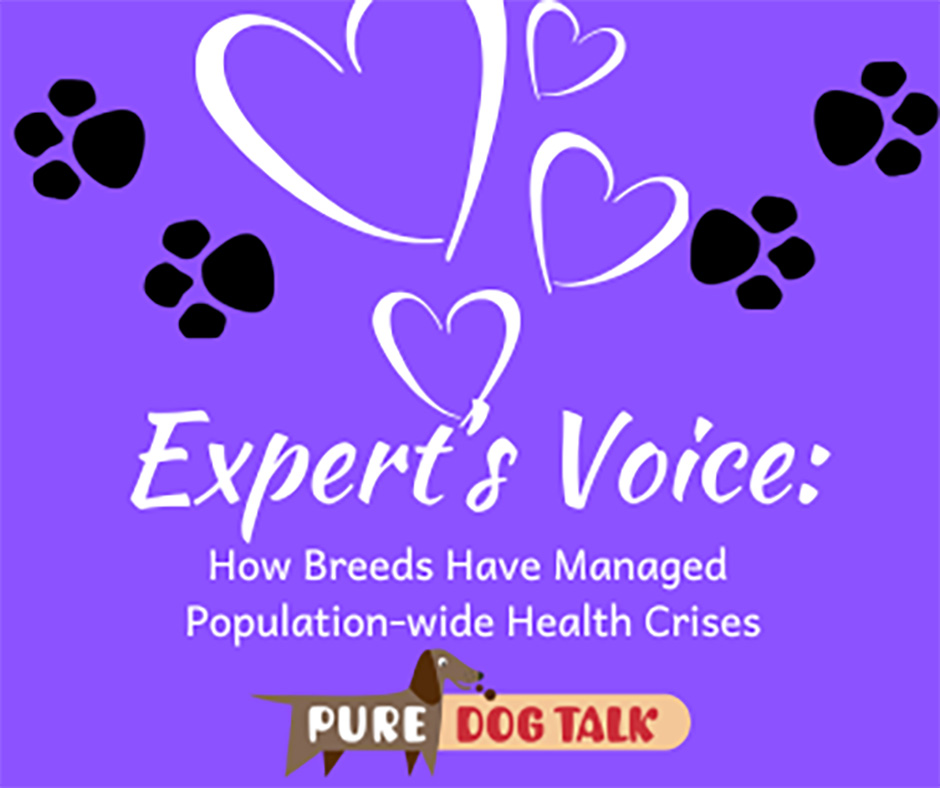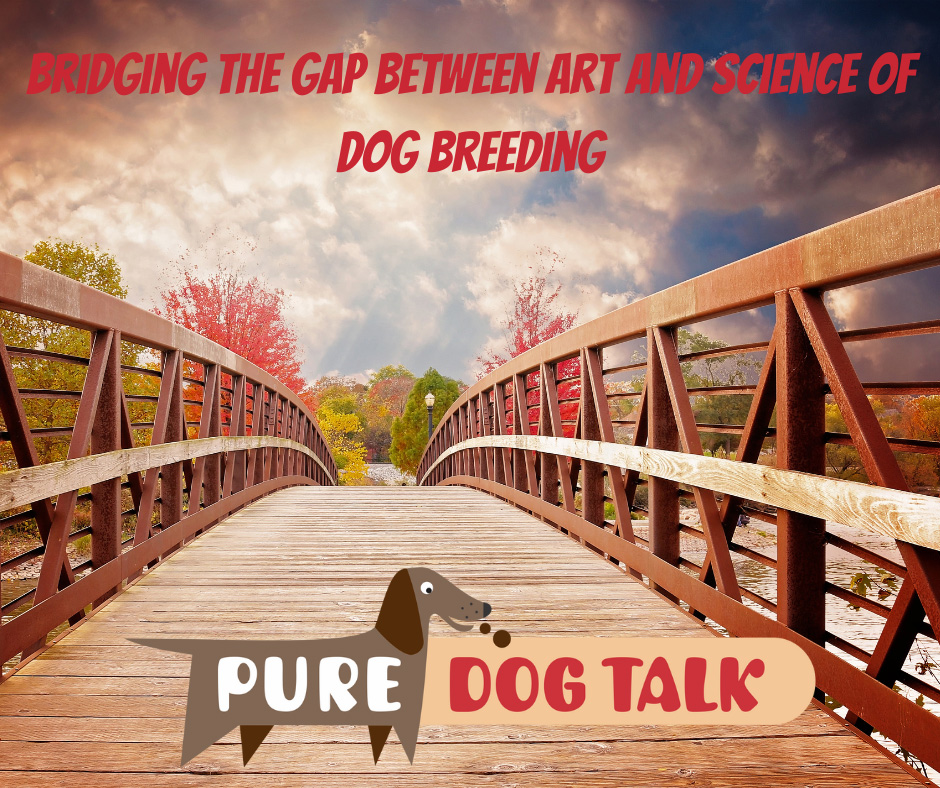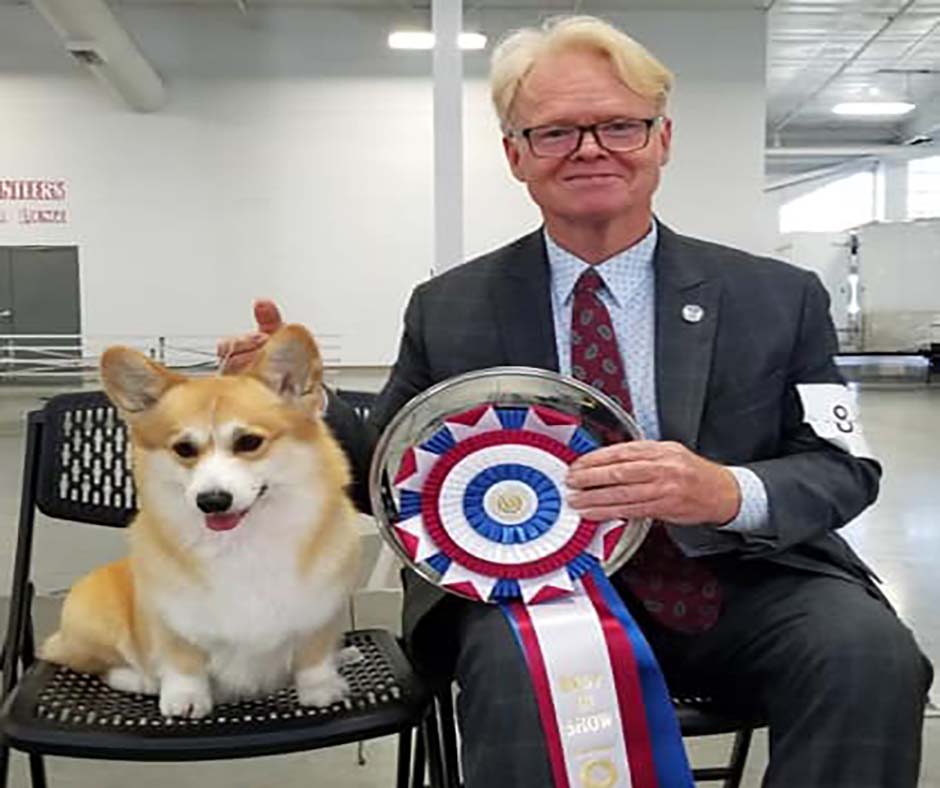659 – When Sh*t Happens in Your Breeding Program
When Sh*t Happens in Your Breeding Program
Host Laura Reeves is joined by Aimée Llewellyn-Zaidi, Project Director, IPFD Harmonization of Genetic Testing for Dogs, International Partnership for Dogs, for part two of a challenging and informative conversation about when sh*t happens in your breeding program.
“If you have a stud dog,” Llewellyn-Zaidi said, “and I’m gonna use stud dogs because that’s what tends to be the bigger contributor to a genetic breeding plan. If you have a stud dog or you’re using a stud dog or you’ve used a stud dog and there is a problem. Step number one is to not panic. Genuinely, that’s the first kind of step, because you will know in yourself that you’ve made the best decisions in that moment with the information you had up until that point.
“You now have maybe new information. So then the second step is investigate and you gave some great examples. Is this something that is heritable? Is this something that isn’t in the breed, but maybe actually is in the breed? And if you start asking, you start realizing that you’re not the only one that has been observing this challenge.
“So just do a little bit of investigating, get a diagnosis for when there isn’t a genetic test. Do a little asking around with friendly people to see if this is something that it is heritable or potentially heritable, and then if it’s something that is kind of unique to your lines or if there’s potentially a broader breed conversation.
“I keep wanting to throw traits because very understandably we focus on poor health, but actually many, many breeders want to be focused on the characteristics that are valuable and important.
“The more we’re able to think about our individual breeding plans as part of a whole, the term collective action, I think the more successful we will be at meeting our goals and reducing the risks of inherited diseases.
“Whether you’re in a healthy breed that has no breed specific health conditions but being a dog means you’re going to have a health condition. Or whether you’re in a breed that has maybe a different path that they need to take to get back to where people feel there’s a better balance between health and the traits that they want, collective action is key.
“And that’s the thing. It’s like the collective action on your individual part is are you communicating with your puppy owners? Are you communicating with the bitch owners if you have the stud but don’t keep the bitches. Who are your breeding friends that you’ve used your stud dog to. Are you keeping those accurate records? Are you including a friendly vet into your system that can kind of help you with identifying or investigating any of these health issues?
“In summation, we’re not gonna panic, we’re gonna investigate, we’re gonna maybe pause breeding and we’re going to think about the steps that we need to take to have those collective action solutions, that’s going to include you and your breeding plans and your breeding partners.”
FPEn291cE5TKEepi1hJv
656 — How Breeds Have Managed Population-wide Health Crises
How Breeds Have Managed Population-wide Health Crises
Host Laura Reeves is joined again by Aimée Llewellyn-Zaidi, Project Director, IPFD Harmonization of Genetic Testing for Dogs at the International Partnership for Dogs. The wide-ranging conversation covers how different breeds have managed population-wide health crises.
Llewellyn-Zaidi discusses specific issues with Irish Setters in the UK and Pointers in the US, as well as Cavalier King Charles Spaniels and French Bulldogs in Finland. She also uses knowledge of the inbreeding in dairy cattle to address some of our questions about the potential of “inbreeding depression” in dogs.
“Education is us making the best decisions we have with the information we have in that moment,” Llewellyn-Zaidi said. “And then where those unintended consequences can go wrong. Bear with me, I’m going to pivot from dogs for just a minute and talk about the dairy cattle industry because I think that is a great warning to the dog breeding world about what we want to keep in mind when we’re making our breeding decisions. (This gives insight into) how we might want to work collectively to solve some of these problems that we’re all facing and also collectively how we might want to achieve the goals and the positive traits and positive characteristics we have in our breeding stock.
“The dairy industry historically had a philosophy of not particularly using a wide number of stud bulls. Their goals when they’re breeding dairy cows are not our goals when we’re breeding dogs. They’re wanting to produce animals that have a very specific trait characteristic, but also are not required for longevity. Generally speaking longevity is kind of a priority for dog breeding. So they had two challenges with that and that if you don’t include longevity or if you are removing those cows at a certain age before their natural lifespan would end then you don’t really know what may be coming into middle or older age.
“There’s a study in 2015, so 10 years ago, where they looked at where the genesis of modern American dairy cattle came from. They realized that all of the American dairy cattle at the moment descended from two bulls from the 1880s. Those were the bulls’ lineages that have survived various breeding strategies over the years.
“If you are a livestock nerd or if you’re interested at all in dairy cattle, you probably have heard of Toy Story, who sired over half a million offspring and he’s within living memory. What’s interesting and, harkening back to our previous conversations again about genetic diversity, funnily enough, in dairy cattle, they started noticing that infertility issues were coming into dairy cows.
“What they didn’t think about or they didn’t really maybe appreciate how inbred those female cows were as well. Because essentially Toy Story was breeding over and over and over and over and over again with his daughters and granddaughters and nieces. So the inbreeding was compounding and they were already inbred to begin with.”
Listen in to hear Llewellyn-Zaidi’s conversation about how different breeds and clubs have solved health issues and genetic diversity questions in positive and constructive ways. And don’t forget to tap in next week for part two.
651 – Bridging the Gap Between Art and Science of Dog Breeding
Bridging the Gap Between Art and Science of Dog Breeding
Host Laura Reeves is joined by Aimee Llewellyn Zaidi, project manager for the International Partnership for Dogs. Llewellyn Zaidi’s work is bridging the gap between art and science in dog breeding. They talk about inbreeding and genetic diversity, how those things go together and what you can do when there isn’t a test for a health problem.
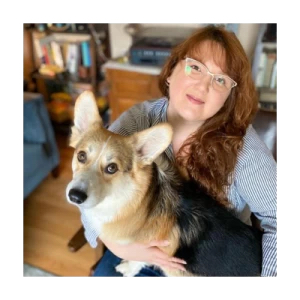
Aimée Llewellyn-Zaidi and her Corgi.
“International Partnership for Dogs offers free resources for dog breeders and for vets to kind of give you some unbiased transparent guidance,” Llewellyn Zaidi said.
“I am a third generation Pembroke Welsh Corgi owner. My grandparents had beef cattle in Oregon in the 1960s. They started their farm up in Silverton, Oregon. And my grandmother was a little bit of an Anglophile. And so she got two corgis back in the 70s in Oregon, which there weren’t too many corgis out here then.
“And she had these great aspirations of having them being working corgis and they worked really hard at cuddling. And they maybe, you know, barked at things, but yeah, they started as working dogs but were 100 % professional lap dogs, you know, as corgis really know how to do it. And I just never lost my love for the Pems.
“I started working as a health manager for the Kennel Club in the UK (in 2012). And by the end of my time in the UK, I had developed a team and I was the head of health and research there, really focused on bringing evidence-based education resources to breeders and to the veterinary community and to breed advisors with lots and lots of tools and resources available.
“I really wanted to take the science and kind of translate it into something practical. There wasn’t a lot of in between at the time between researchers and the people who actually have to make the breeding decisions and that disconnect really bugged me. I think it really bugged me that there wasn’t such an easy way for communication between really the art and the science of dog breeding, trying to bring those things a little bit closer together.
“I want to take some of the mystery out of some of science or some of the resources that are available. I try to be really honest and transparent about what we know, what we don’t know, what’s still kind of out there, what things might be not the most ideal resources.
“I feel like that honesty is the best way for people to be informed and to make ultimately the breeding decisions. You guys have the hard job. You have the job of deciding, right? So, I just want to give you information that can help you hopefully make those really informed decisions.”
307 – Bill Shelton, part 2: Breeding for Genetic Diversity
Bill Shelton on Breeding for Genetic Diversity, Breeding Up and More
In part two of our series, Bill Shelton, leading advocate for preservation dog breeders, and host Laura Reeves have a spirited conversation about how to improve the health of our breeds while maintaining genetic diversity.
“Leading theriogenologists say breeders are suppressing genetic diversity,” Shelton said. “Only testing phenotype not genotype in hip x-rays for example, removes dogs from the gene pool without understanding the genotype. When we eliminate genes for one thing we don’t know what genes we’re removing that are positive.”
Lethal genes must be removed, but until we have a DNA genetic marker we don’t really know, Shelton noted. We need to breed carriers and potentially affected as well in order to preserve a variety of genes for the future.
Weaving genes to make a healthier dog
“We are asking more of our dog breeding programs than we are for our own humanity,” Shelton said. “We’re actually holding dogs to a higher standard than ourselves and the future of humans.”
Taking the conversation full circle, Shelton noted that legislators are listening to extremists rather than experts in animal husbandry.
Messaging… Again!
“We need to get our message out there,” Shelton said. “We need to have more advocacy for purebred dogs. We need to step outside this circle of dog shows.”
In an outside-the-box idea, Shelton suggested that AKC needs to consider rebranding as an option, to call themselves a conservancy of heritage breeds.
“How we talk about what we do is what’s important,” Shelton said.
In the “other great ideas department,” Shelton asked rhetorically, “Where is the breeder’s committee in the delegates? Where is the VP of breeders at AKC?”
“We need to take the focus away from showing and put our focus on breeding dogs,” Shelton said. “We are at the point that an amateur delegate body is running what has become a professional industry. Everyone makes money. Who doesn’t make money? Dog breeders.”
If you missed part 1, listen here.
237 — DNA Genetic Testing Prevents Bottlenecks, Promotes Diversity
DNA testing can provide useful information for all breeders
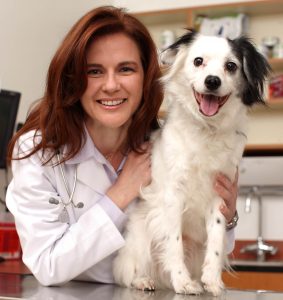
Angela Hughes DVM PhD, Veterinary Genetics Research Manager, Wisdom Health
Testing our dogs’ DNA provides details on everything from ancestry in mixed breeds to disease mutations and genetic diversity in purebred dogs. Dr. Angela Hughes, Veterinary Genetics Research Manager at Wisdom Health, talks about the different types of DNA genetic testing.
“A breed is a specific combination of alleles,” Hughes said. “And 99 percent of the DNA in a Great Dane is the same as a Chihuahua. It’s that one percent that is so important.”
DNA Panel tests, Hughes said, test for genetic mutations. The Wisdom Health Optimal Selection panel tests for 180 different specific diseases that are broken out by which are identified and correlated within each breed.
Focus on genetic diversity.
“Studies show that losing genetic diversity causes loss of reproductive health, increased disease incidence, even decreased hunting ability,” Hughes said.
Purebred dog breeders are succeeding with test and replace breeding theories, Hughes believes. She referenced a study of dogs in the U.S., mixed breed and purebred, in which of all diseases tested for, 34 disorders were found only in mixed breeds, not in purebred dogs.
While Hughes acknowledges that “you can have healthy highly inbred dogs,” she notes that breeders have to be incredibly selective to achieve that.
“The average breeder doesn’t have the time and resources, the number of dogs necessary or enough information to be that highly selective,” Hughes said.
Genetic diversity in dogs will be different even in full siblings, Hughes said. For full littermates, on average, about 50 percent of the DNA is the same. This power of DNA testing, Hughes noted, is that it can help identify which of two dogs, similar in quality and pedigree, is the best match in terms of genetic diversity. Simple pedigree analysis and COI (coefficient of inbreeding) can’t provide that information.
Skip the Bottleneck
The diversity testing also helps avoid bottlenecks in a breed’s gene pool due to popular sire syndrome. She defines this as any sire with more than 100 puppies produced. In an example based on studies of Golden Retrievers in England, in a gene pool of six generations, with 31,259 individual animals represented, the testing revealed only 67 genetically unique individuals.
“DNA testing doesn’t tell you who to breed, it tells you who to breed to,” Hughes reiterated. “This is the last piece. Do all the other testing – conformation, temperament, health, function – then do this.”
Importantly, Hughes also noted that breeders should be careful to not lose the “essence of the breed” in search of genetic diversity.
“You want to move the needle,” Hughes said. “Just shift the curve in the direction of diversity.”
https://www.optimal-selection.com/
164 – Busting the Genetic Testing Myths: Dr. Jerold Bell|Pure Dog Talk
Stick around for input from Allison Foley at the Leading Edge Dog Show Academy about tips for successfully using a flat iron to groom drop-coated dogs.
And take a minute to stop by https://blog.feedspot.com/dog_podcasts/ and check out the top 15 dog podcasts! Of which we are one!


